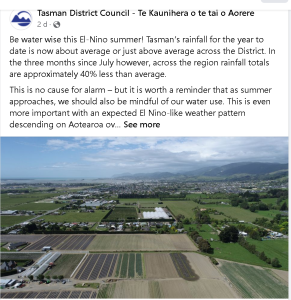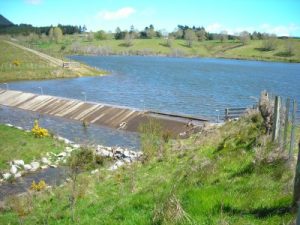Summer is fast approaching and according to the NZ Herald “There’s now also a good chance the long-anticipated climate system – which could be formally declared within weeks – will sit among the strongest El Niños seen in the past 80 years, with officials already warning of fire danger and a heightened risk of drought.”

So, it is a good job that the $200 million dam (give or take – as the final bill is yet to be presented) is on track to provide much needed water to the Waimea Plains and surrounding homes and businesses. At least that was the last we heard from the dam construction CEO Mike Scott.
Perhaps in an ordinary year it wouldn’t be such an issue if the dam wasn’t completed as indicated but this is no ordinary year. Not only do we have the impending threat of an El Niños weather pattern bringing a particularly dry summer, but we also have a district facing financial ruin without any added stresses.
The Government’s best attempts to bankrupt the country have very nearly succeeded. Covid lock-downs, excessive taxes and added costs, high wages and reduced work forces, out of the park inflation accompanied by the hiking interest rates to control it, all add up to many in the primary industry sector relying on a bumper crop to keep afloat. Without the added costs added by a Council equally drunk on spending other people’s money.
Now imagine the unthinkable: that $200 million (give or take) spent on dam insurance for such a time as this comes up short.
Clearly there has been no indication from Mike Scott that there are any issues to concern us. Council has been equally silent. Or have they?

It seems odd that the Council is issuing conserve water adverts. The dam that was supposed to provide 100 years water security, included massive provisions for growth in our urban communities. In fact, not only did we buy enough security for expected “high growth” figures for our district, but when the irrigators first began pulling back on their commitments the Council bought up extra shares in the dam. So with all this extra capacity up our sleeve in year one of the dam operation we should be swimming in water. And yet the message is inconsistent with this position.
Possibly, the Council are just being prudent in case the predicted drought turns out to be the mother of all droughts and exceeds the copious growth buffer that we bought. Because once operating at full growth capacity the dam only provides security for a one in sixty year drought. An extreme drought will still evoke water restrictions in that scenario.
Possibly, the dam is not fully functioning as indicated. We have history that would indicate the rate-payer has been grossly mislead before. For instance, the dam had a P95 at $76 million; the dam was “as good as fixed price” at $104 million; they had found bedrock – better than expected in some places.
One thing is for certain: the clock is ticking. And time is a great revealer of sins and lies.
When the dam was at a mere $158 million I made a predictive statement based on the evidence presented to me. Tick Tock Tick Tock.









